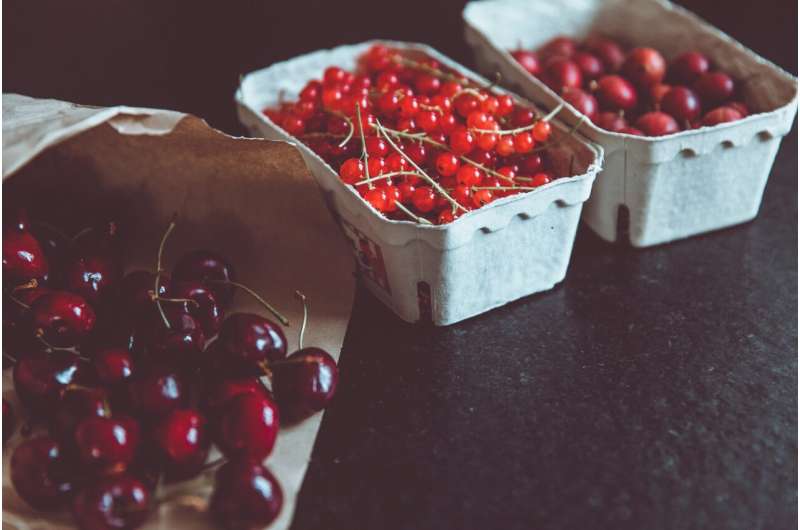This article has been reviewed according to Science X's editorial process and policies. Editors have highlighted the following attributes while ensuring the content's credibility:
fact-checked
trusted source
proofread
New markets on the menu with plant biosecurity tool

Global trade is important and brings many benefits. But trade can also spread pests and pathogens that harm agricultural crops and the natural environment.
For farmers and exporters, identifying the best combination of measures to prevent the spread of pests and diseases is complex. Particularly, in order to comply to the different needs of trading partners.
A new science-backed menu of measures aims to make this easier. The tool has been developed through the Trusted Agrifood Exports Mission in partnership with Hort Innovation. It will help keep trade flowing and open up new markets for Australia, while protecting biosecurity.
What's on the menu?
CSIRO's Rieks Van Klinken, leads research and development on market access for the Trusted Agrifood Exports Mission.
Dr. Klinken and his team conducted a global review to see what biosecurity measures are being used, how these measures reduce plant pest risk, and how their effectiveness is demonstrated.
"We found only 39 different types of measures," Dr. Van Klinken said.
"Many are underutilized because they don't have adequate scientific, trade and regulatory frameworks in place. As a result, market access agreements often rely on just a few, well-known measures."
The menu raises awareness of the wider range of risk mitigation options that could be used.
Regulators have tended to rely on a limited range of measures—such as fumigation or cold treatment.
The menu highlights many other options. These may be more compatible with contemporary supply chains and could reduce reliance on harsh chemical treatments, for example.
Trialing biosecurity measures from the menu
In a recent trial, growers in New South Wales and Victoria used a mix of measures from the menu to produce more than 17,000 tons of cherries. The trial detected no Queensland fruit flies in 70 consignments for trade to South Australia and Western Australia.
So rather than following a program of "calendar spraying," growers can monitor pests and beneficial insects on farm and respond with sprays only as necessary. This integrated pest and disease management can reduce chemical use while still managing biosecurity risks.
Another example highlights how Australia could get produce to markets in Asia faster.
Producers could use in-field crop monitoring with optical scanning at the packing stage, instead of longer traditional processes such as fumigation. This would allow premium quality fruit to reach Asian markets within 24 to 48 hours of picking.
Making the export supply chain faster and smoother with more streamlined biosecurity measures could improve our competitiveness in premium markets, grow export volumes and bring greater returns for Australia.
It's something many export industries are looking at to boost returns using innovation and technology. For example, the cherry industry has set itself the target of exporting 40% of production by 2025, up from 23% of production exported last financial year.
Harnessing technology in agricultural production and supply chains
"We developed the tool to help regulators and trading partners recognize and quantify the things that farmers already do to reduce risk.
"For example, we could extend the use of optical scanning imaging technology in fruit grading to also find and remove infested fruit.
"The menu can help drive innovation and opportunities to harness commercial practices and supply chain technologies that can contribute to biosecurity.
"This is transformational biosecurity beyond some of the usual options for reducing trade-related biosecurity risks, such as fumigation of fresh produce and checking produce shipments at borders," he said.
Building the science behind plant biosecurity
"We want to keep improving the science-base for plant biosecurity.
"We also want to build international agreement on how to demonstrate the effectiveness of risk management measures—especially for the lesser-known measures or options arising from newer technologies.
"This could help increase international trade opportunities for Australian exporters while reducing plant pest risks," Dr. Van Klinken said.
"Australian farmers are already doing a great job at producing fresh produce that is free of pests and diseases.
"Ultimately we want to give producers a wider range of management options to efficiently reduce biosecurity risks that are recognized for both interstate and international trade," he said.
On a mission to further grow trust in Australia's agrifood exports
Development of the menu of measures tool is a key outcome from the Trusted Agrifood Exports Mission. The Mission is a partnership between CSIRO, the Department of Agriculture, Fisheries and Forestry, and Meat & Livestock Australia to digitally transform Australia's agrifood supply chain and grow export premiums across commodities.
Together we're aiming to boost the global export earnings of Australian grown food by 2030 through tools and technologies that verify our food quality, safety and sustainability credentials.
As a next step, a comprehensive digital resource is being developed in collaboration with biosecurity specialists in the Australian and state governments to provide more detail about each measure in the menu and what evidence is required to support their use in trade arrangements.
Explore the interactive menu of measures prototype. Or find out more about CSIRO's work on managing plant biosecurity risks related to trade.
Provided by CSIRO





















